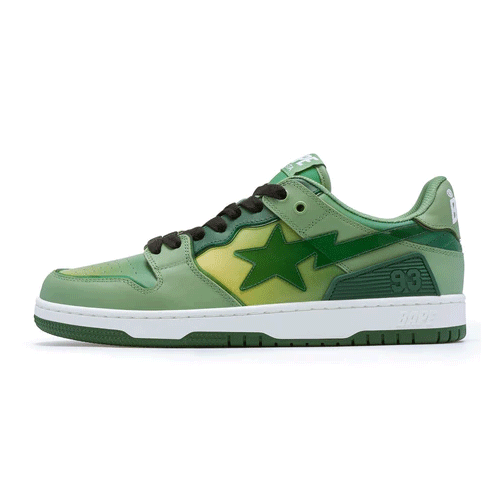In the ever-evolving world of sneakers, few models have maintained the cultural cachet and cult following like the Bapesta. Born from the fusion of Japanese streetwear creativity and global sneaker aesthetics, Bapesta is more than just footwear—it’s a fashion statement, a cultural reference, and a collector’s dream.
Created by A Bathing Ape (BAPE), the legendary Japanese streetwear label founded by Nigo, Bapesta sneakers are instantly recognizable thanks to their bold silhouettes, flashy colors, and the iconic shooting star motif that mirrors the Nike Air Force 1. For many, owning a pair of Bapestas is not just about the look—it’s about belonging to a rich, rebellious legacy.
The Origins of Bapesta: A Cultural Remix
Bapesta made its first appearance in the early 2000s when BAPE was rapidly rising as a counter-cultural powerhouse in Harajuku, Tokyo. Nigo, influenced heavily by Western hip-hop and sneaker culture, wanted to create a shoe that reflected that influence while embedding Japanese uniqueness.
Taking clear inspiration from the Nike Air Force 1, the bapesta
the Swoosh with a star-and-lightning bolt logo, while introducing more experimental materials, louder patterns, and unapologetically vibrant colorways.
While some accused it of being a “knockoff,” fans and fashion insiders saw it as an artistic remix—a reinterpretation of a classic through a Japanese lens. What followed was a cult explosion.
The Rise to Icon Status: Hip-Hop, Hype, and History
What truly catapulted the Bapesta into mainstream consciousness was its embrace by hip-hop culture in the early to mid-2000s. Rap artists such as Pharrell Williams, Kanye West, and Lil Wayne were early adopters of BAPE, with Pharrell and Nigo even launching the Billionaire Boys Club (BBC) and Ice Cream brands together.
Bapesta wasn’t just a sneaker—it was a symbol of exclusivity, street credibility, and creative rebellion. In an era when streetwear was just starting to intersect with high fashion, Bapesta bridged that gap perfectly.
Limited releases, celebrity endorsements, and a high resale value only made the silhouette more desirable. Every new drop felt like an event. For many sneakerheads, owning a pair of Bapestas meant being part of an insider circle.
Design Language: Why Bapesta Stands Out
One look at the Bapesta and you immediately understand its aesthetic intent: be loud, be seen, and be different.
Unlike traditional sneakers that often stick to neutral tones and minimalism, Bapestas come in patent leather, metallic finishes, camouflage patterns, and unpredictable color combinations. It’s a sneaker that doesn’t whisper; it shouts.
The star logo—often compared to a comic book explosion—is placed exactly where a Nike Swoosh would go, creating an uncanny familiarity. However, it’s the materials and detailing that give the Bapesta its own identity. Even the outsole mimics the Air Force 1, making it a bold homage rather than a mere imitation.
The brand has also released Bapesta Mid and Bapesta FS (Foot Soldier) editions, offering a twist to the original silhouette and appealing to fans of all preferences.
Collaborations That Defined the Sneaker
Part of what keeps Bapesta relevant is its history of memorable collaborations. BAPE has mastered the art of cross-brand synergy, often teaming up with other labels and artists to create sneakers that double as collectibles.
Some standout collaborations include:
Bapesta x Kanye West “Dropout Bear” – A grail for many, inspired by the cover art of Kanye’s debut album The College Dropout.
Bapesta x Marvel Comics – Featuring superhero-inspired designs that blended comic book nostalgia with streetwear edge.
Bapesta x DC Shoes, Hello Kitty, and even Pepsi – Each release proving that no idea is off-limits when it comes to the Bapesta universe.
These collaborations pushed the boundaries of sneaker design and gave the Bapesta a lasting place in pop culture.
Bapesta vs Air Force 1: A Necessary Comparison
You can’t talk about Bapesta without addressing the elephant in the room: the Nike Air Force 1. While the resemblance is undeniable, the differences are worth noting.
Bapesta is less about performance and more about fashion. It’s meant for the streets, not the court. While Air Force 1s lean toward athletic wear with minimalist appeal, Bapestas go full throttle on expression, often designed to be statement pieces rather than everyday kicks.
Legally and culturally, the comparison sparked debates. But over time, the Bapesta carved out its niche—not in competition with the Air Force 1, but as an alternative for those seeking louder, rarer, and more artistic versions of a classic silhouette.
How to Style Bapesta Sneakers
Styling Bapestas takes confidence. These sneakers are not background players—they’re the main event.
Pair them with cargo pants, baggy jeans, or track pants to keep the streetwear vibe authentic. Add a graphic tee, oversized hoodie, or vintage jacket to complete the look. The key is to let the sneakers stand out, so avoid over-accessorizing.
Color coordination is critical. Since most Bapestas feature bold hues or prints, match with neutral or complementary tones. If you own a solid black or white pair (rarer, but they exist), they can become surprisingly versatile additions to your daily rotation.
The Resale Market and Collector Culture
Like any streetwear grail, the Bapesta has a thriving resale ecosystem. Limited releases and high demand have created a strong collector culture around the shoe.
Vintage Bapestas from the early 2000s can fetch hundreds—even thousands—on resale platforms. Condition, collaboration, and rarity all factor into the price.
In recent years, BAPE has re-released some classic models and introduced new designs, which has reignited interest among younger sneakerheads who may have missed the original wave.
If you’re looking to start a collection, prioritize condition and authenticity. There are fakes in circulation, so buying from reputable sellers is essential.
Bapesta in Today’s Streetwear Landscape
In an era dominated by Yeezys, Jordans, and Dunks, one might wonder: where does Bapesta fit in?
Surprisingly, the silhouette has aged well. Recent fashion trends are moving back toward maximalism, vintage looks, and early 2000s nostalgia—all of which favor the Bapesta aesthetic.
Moreover, the new generation of rappers and influencers have brought the brand back into the spotlight. Artists like Playboi Carti, Tyler, the Creator, and ASAP Rocky have all shown love for the silhouette.
Bapesta isn’t just riding the wave—it’s helping create it.
Final Thoughts: Why Bapesta Still Matters
Bapesta represents more than just another sneaker. It’s a story of cultural fusion, artistic rebellion, and streetwear evolution. From its controversial beginnings to its current revival, the silhouette has proven its staying power.
For sneakerheads, fashion purists, and collectors alike, the Bapesta remains an essential part of the conversation. Whether you’re buying your first pair or digging through resale platforms for a rare collab, one thing is clear: Bapesta is timeless, loud, and here to stay.
 :
http://bapesta.net
:
http://bapesta.net

